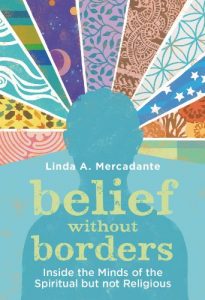 Belief without Borders: Inside the Minds of the Spiritual but not Religious by Linda A. Mercadante
Belief without Borders: Inside the Minds of the Spiritual but not Religious by Linda A. Mercadante
Reviewed by Oliver Robinson
There is a demographic revolution going on in the Western world. Several decades back, the label of ‘spiritual but not religious’ (SBNR) did not exist. Now surveys suggest that up to a quarter of the population endorse that option. Linda Mercadante, a professor of theology, has done a major study in the US to find out more about this group and what they believe. This research is presented and summarised in accessible form in Belief without Borders: Inside the Minds of the Spiritual but not Religious.
The book is set up in a subtle way that makes the distinction between spirituality and religion both relevant and problematic. It is problematic in that it is often over-simplified as “religion = dogma and convention” and “spirituality = experience and individualism”, and this problem is compounded by the fact that SBNR individuals tend to over-simplify in this way. In fact, the distinction is far messier than that. Religion contains liberal, critical and highly individualised forms of belief and worship as well as more exclusivist and dogmatic forms, while spirituality contains varied formulations, some of which have a form of dogmatism and exclusivism of their own in being cocksure of their superiority. I appreciated Mercadante’s approach to this breaking this distinction down – it was considerably more nuanced than I have found in most other books on the subject.
Mercadante categorises her SBNR interviewees into five types. Dissenters intentionally stay away from institutional religion and are critical of it. They tend to reject particular theological positions, and select a personal worldview that is intentionally contrary to the religion that they grew up with. Casuals are not so bothered. Spirituality is neither something that captures their attention nor organises their life. They dip in ‘as needed’. Spiritual practices are for them primarily a way toward better health, stress relief and emotional support. Explorers show a fascination with all things spiritual. They tend to try one thing out and then another, seeking novelty and new experiences. They have no plans to settle anywhere, enjoying the journey without any hope of a destination. Seekers are much like explorers, but the difference is that they are looking for a spiritual home. Immigrants are those who have moved to a new spiritual land and trying to adjust to new identity and community, while still identifying as SBNR. Mercadante found this group struggling with the constancies of religious life, and suggests that something about the independence and freedom of the SBNR designation may make the commitment and group loyalty of a religious community difficult.
In the context of a very hazy division between spirituality and religion, what does define being SBNR? Despite the prize attached to being individual and unconventional in the SBNR world, the interviewees in the study showed a clear and common heritage in their beliefs. They were, however, often unaware of this heritage, thinking that their own ideas were new and even unique. In fact, they were drawing on ideas and language from Swedenborgianism, Transcendentalism, Romanticism, spiritualism, esotericism, Theosophy, New Thought and Asian religions. They also were drawing on the Protestant lineage of individual interpretation and allowance of criticism to be part of faith.
In her analysis of the key themes in belief, she picks out as particularly common in the SBNR ethos. Firstly, spirituality is based on a hero myth structure of overcoming the ego through a quest of self-improvement, which requires undertaking a host of therapeutic, artistic and spiritual practices. Secondly, exclusivism – the idea that one idea has the truth – is rejected in favour of a “perennialist” approach that sees all spiritual concepts as relative, but the mystical experience as absolute and truth-giving. Experience in this belief set is the ultimate touchstone, so interpretations and concepts should follow it. Thirdly, the choice to be SBNR is based on perceived ethical shortcomings in religious groups, including prejudice, homophobia and fear of the other. Finally, there is the belief in the validity of syncretism – the bringing together of diverse ideas and practices and integrating them in an individual and improvised personal system. The postmodern values of uncertainty, fluidity, subjectivity and relativism are all richly espoused in SBNR, but typically within a worldview that places spirituality as a higher expression of the sacred than religion. It seems that Mercadante is, as a Christian, slightly irritated by the superiority that she sees hiding behind SNBR’s espoused pluralism, and one can understand why.
Overall, the book has a strong balance of description, evaluation and criticism and is, as yet, one of only a few major empirical studies on the SBNR revolution.
Mercadante does a good job of arguing for and against the worth of the SBNR label. On one side, it could be as a narcissistic descent into spiritual navel-gazing, while on the other, it could be a healthy flood of spiritual passion out of religious institutions into the world at large. In Linda Mercadante’s view (and mine too) it’s probably both.
Olly Robinson is Senior Lecturer at the University of Greenwich and author of “Paths Between Head and Heart: The Seven Harmonies of Science and Spirituality”, to be published in 2017 by O Books.
